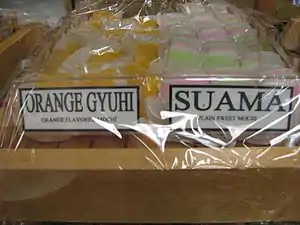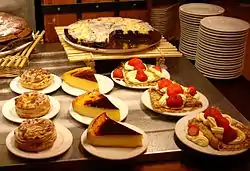List of Japanese desserts and sweets
The Japanese were making desserts for centuries before sugar was widely available in Japan. Even when sugar became affordable in Japan still dessert was widely available in Japan and used in Japan. There are many common desserts still available in Japan which can be traced back for hundreds of years.[1] In Japanese cuisine, traditional Japanese sweets are known as wagashi. Ingredients such as red bean paste and mochi are used. Many modern-day sweets and desserts in Japan are also in existence.
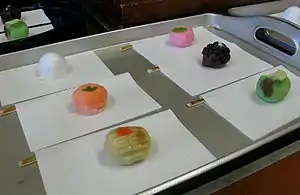
Japanese desserts
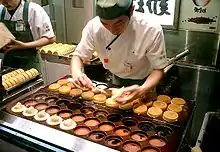
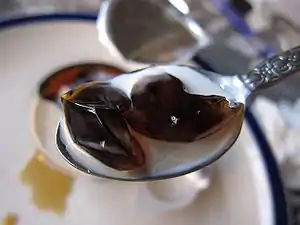
- Amezaiku
- Anmitsu
- Anpan
- Castella
- Chinsuko
- Coffee jelly
- Green tea ice cream
- Hakuto jelly
- Imagawayaki
- Melonpan
- Mochi ice cream [2]
- Momiji manjū [3]
- Purin
- Raindrop cake
- Sata andagi
- Tokyo banana
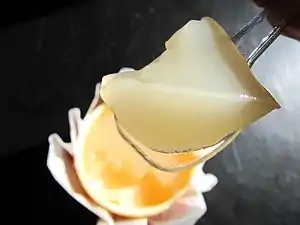 Hakuto jelly is a seasonal dessert in Japanese cuisine available in the summer.
Hakuto jelly is a seasonal dessert in Japanese cuisine available in the summer.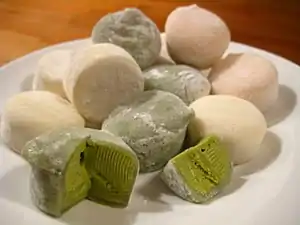 Mochi ice cream is a Japanese confection made from mochi (pounded sticky rice) with an ice cream filling.
Mochi ice cream is a Japanese confection made from mochi (pounded sticky rice) with an ice cream filling.
Wagashi
Wagashi (和菓子) is a traditional Japanese confectionery which is often served with tea, especially the types made of mochi, anko (azuki bean paste), and fruits. Wagashi is typically made from plant ingredients.[4] Wagashi are made in a wide variety of shapes and consistencies and with diverse ingredients and preparation methods. Wagashi are popular across the country japan but are only available regionally or seasonally. [5]
A
B
C
D
 Daifuku is a glutinous rice cake stuffed with sweet filling, most commonly anko, sweetened red bean paste made from azuki beans.
Daifuku is a glutinous rice cake stuffed with sweet filling, most commonly anko, sweetened red bean paste made from azuki beans.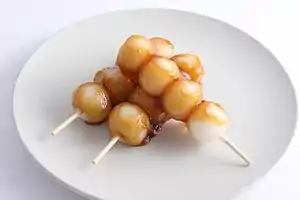 Dango is a dumpling and sweet made from mochiko (rice flour), related to mochi. It is often served with green tea.
Dango is a dumpling and sweet made from mochiko (rice flour), related to mochi. It is often served with green tea.
G
H
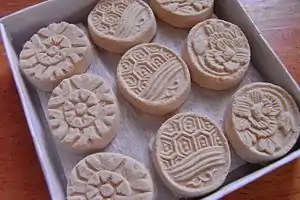
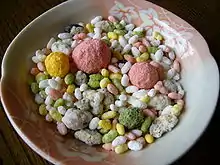 Arare is a type of bite-sized Japanese cracker made from glutinous rice and flavored with soy sauce. Sweet and savory varieties are prepared.
Arare is a type of bite-sized Japanese cracker made from glutinous rice and flavored with soy sauce. Sweet and savory varieties are prepared. Hanabiramochi is a Japanese sweet usually eaten at the beginning of the year.
Hanabiramochi is a Japanese sweet usually eaten at the beginning of the year.
I
K
M
N
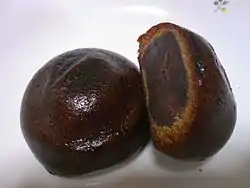 Manjū is a popular traditional Japanese confection; most have an outside made from flour, rice powder and buckwheat and a filling of anko (red bean paste), made from boiled azuki beans and sugar.
Manjū is a popular traditional Japanese confection; most have an outside made from flour, rice powder and buckwheat and a filling of anko (red bean paste), made from boiled azuki beans and sugar.
 Monaka is prepared with azuki bean jam filling sandwiched between two thin crisp wafers made from mochi.
Monaka is prepared with azuki bean jam filling sandwiched between two thin crisp wafers made from mochi. Namagashi are a type of wagashi, which is a general term for snacks used in the Japanese tea ceremony. Namagashi may contain fruit jellies, other gelatines such as Kanten or sweetened bean paste.
Namagashi are a type of wagashi, which is a general term for snacks used in the Japanese tea ceremony. Namagashi may contain fruit jellies, other gelatines such as Kanten or sweetened bean paste.
R
S
- Sakuramochi
- Senbei
- Shiruko (red bean soup)
- Suama
T
U
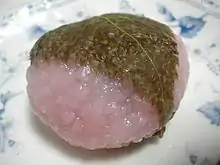 Sakuramochi consists of a sweet pink mochi (rice cake) and red bean paste, covered with a leaf of sakura (cherry blossom).
Sakuramochi consists of a sweet pink mochi (rice cake) and red bean paste, covered with a leaf of sakura (cherry blossom).
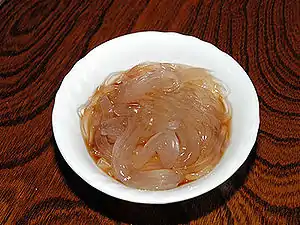 Tokoroten is prepared with jelly extracted from seaweeds such as tengusa (Gelidiaceae) and ogonori (Gracilaria) by boiling. Pressed against a device, jelly is shaped into noodles.
Tokoroten is prepared with jelly extracted from seaweeds such as tengusa (Gelidiaceae) and ogonori (Gracilaria) by boiling. Pressed against a device, jelly is shaped into noodles.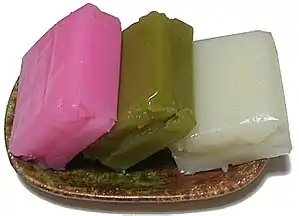
W
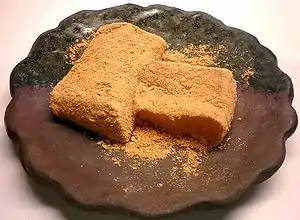
Y
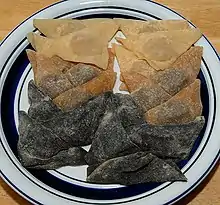 Assorted Yatsuhashi. The flavors, from top to bottom, are tofu, cinnamon, sesame.
Assorted Yatsuhashi. The flavors, from top to bottom, are tofu, cinnamon, sesame.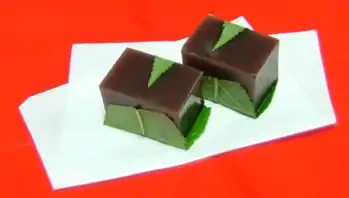 Yōkan is a thick, jellied dessert made of red bean paste, agar, and sugar. It is usually sold in a block form, and eaten in slices.
Yōkan is a thick, jellied dessert made of red bean paste, agar, and sugar. It is usually sold in a block form, and eaten in slices.
See also
Japanese sweets and desserts
Related topics
References
- 38 Japanese Desserts. (n.d.). Retrieved from https://www.japan-talk.com/jt/new/japanese-desserts
- Watanabe, Teresa (2012-11-07). "Frances Hashimoto dies at 69; Little Tokyo leader, mochi ice cream creator". Los Angeles Times. Retrieved 2012-12-02.
- Japanese inn & travel: illustrated. Eibun Nihon etoki jiten. Japan Travel Bureau. 1990. p. 137. Retrieved August 19, 2017.
- Gordenker, Alice, "So What the Heck is That?: Wagashi", Japan Times, 20 January 2011, p. 11.
- (n.d.). Retrieved from https://www.japan-guide.com/e/e2312.html
- "ういろう" [Uirō]. Dijitaru daijisen (in Japanese). Tokyo: Shogakukan. 2012. OCLC 56431036. Archived from the original on 2007-08-25. Retrieved 2012-06-24.
External links
 Media related to Confectionery of Japan at Wikimedia Commons
Media related to Confectionery of Japan at Wikimedia Commons Media related to Sweet food of Japan at Wikimedia Commons
Media related to Sweet food of Japan at Wikimedia Commons Media related to Wagashi at Wikimedia Commons
Media related to Wagashi at Wikimedia Commons


